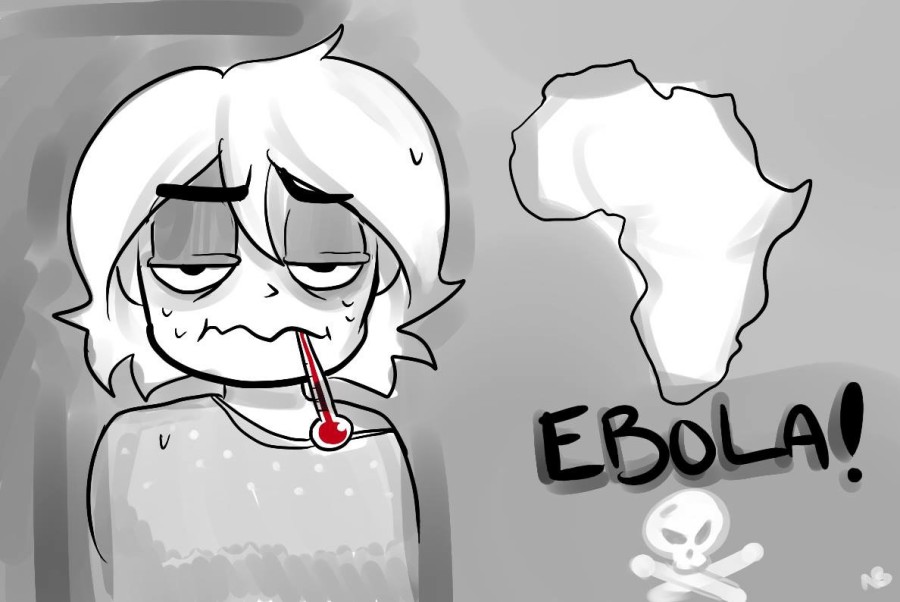The truth about Ebola
December 5, 2014
Ebola hemorrhagic fever, or more commonly known to the public as Ebola, is the panic- causing-pandemic that is sweeping the nation, despite the reassurance of low chances of an outbreak in the United States by the CDC (Centers for Disease Control and Prevention).
Ebola or previously known as Zaire ebolavirus is a virus in the Filoviridae family. The virus only causes disease in humans and nonhuman primates such as monkeys, gorillas and chimpanzees. This virus causes severe hemorrhagic fever that is often fatal.
According to the CDC, the Ebola virus was found in 1976 near the Ebola river, which is located in the Democratic Republic of the Congo. Since then, outbreaks have occurred intermittently in Africa. The 2014 outbreak of Ebola is the largest in recorded history, and it is currently affecting numerous nations in West Africa. Such nations include Guinea, Liberia and Sierra Leone. The entirety of these countries are affected, while countries like Mali, Spain, Nigeria, Senegal and the United States are experiencing minimal to no transmission.
Ebola spread quickly in Africa because many of the countries there are less developed, which often coincides with having less advanced technology to contribute to their ability to fight and contain very infectious and fatal diseases. In the US, a developed country, healthcare is a priority and advanced technology is abundant. The ability to effectively quarantine infected persons is much greater in the U.S. than in developing countries such as Sierra Leone, Guinea, and Liberia.
Symptoms of Ebola include headache, severe fever, muscle pain, weakness, fatigue, diarrhea, vomiting, abdominal pain and unexplained hemorrhaging. These may appear in a span of 2-21 days after subjection to Ebola. The average time for symptoms to appear is 8-10 days, according to the CDC official information.
Many of these symptoms mimic those of Influenza, which is more commonly known as the Flu. The real difference in the symptoms is that Ebola can cause stomach pain and unexplained hemorrhaging. If experiencing any of the symptoms above, see a certified doctor for evaluation.
As for prevention, the methods are very similar to preventing any infection, whether it be the common cold or Ebola. Prevention starts with washing hands.
“I have a basic rule. If it’s warm, wet and didn’t come out of you, don’t touch it,” says school nurse Dana Kelleher. “And if you have to, use gloves, a mask, the basic ways to protect yourself.” Other basic ways to prevent getting Ebola are avoiding contact with someone who has had Ebola, or had Ebola (deceased infected persons)
Many are worried about the severity of Ebola, and since reaching the United States, the trepidation surrounding the disease has only increased. But most of the panic is excessive. There have been many rumors surrounding Ebola, the greatest concern being the virus mutating and becoming airborne. This is highly unlikely. According to the Washington Post, the virus would have to mutate from attaching to cells in the circulatory system, to attaching to cells in the lungs. A mutation of such complexity is “a genetic leap in the realm of science fiction.”
As for a vaccine, France’s National Institute of Health and Medical Research has created an antiviral drug that has succeeded in a majority in non-human test subjects, and the potential cure has been rushed to Gueckedou, Guinea. According to CBSNews, fast moving clinical trials will begin soon.
The chances Ebola will reach Gig Harbor are slim. The quarantines in the U.S. are currently in Dallas, Texas and New York City, each of which are more than 2000 miles away from Gig Harbor.
“I think the chances are very low. In this world there’s lots of travel and disease spreads faster than it used to,” says Kelleher. “But that said, they [The CDC] are working on quarantines and making sure exposed people don’t have symptoms and that’s really reassuring. The chances someone will bring it back without being quarantined and monitored are little to none.”
The facts are astounding, and clear. The panic of Ebola is unwarranted in the United States. The U.S. is a developed country with an effective disease control sector of government.
“People want to make it all fancy and blow it out of proportion,” Kelleher says. “Ebola is just a disease, and we have a lot better ways of containing it than many other places do.”
For more information on Ebola, visit the CDC official website at http://www.cdc.gov/vhf/ebola/index.html












